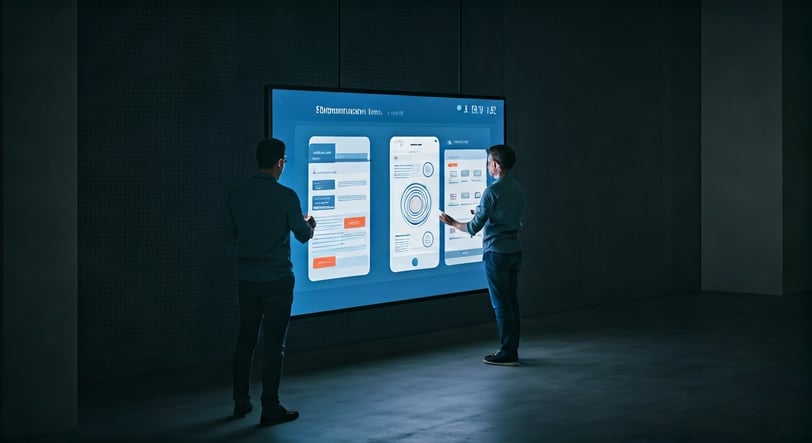
Mobile App Development Life Cycle Explained
Creating mobile applications needs a well-thought-out mobile app development life cycle. Every step, from coming up with the idea to looking after the app after it launches, has its own role in building a successful app. This full process gives developers a clear path to follow. It lets them meet user needs and their business targets in the right way. If you get to know and move through this application development life cycle, your team can skip problems, face new things easier, and finish on time. Read this guide to find out about the important steps in the mobile app development process.
MOBILE APP DEVELOPMENT
Key Highlights
The mobile app development life cycle is a structured process encompassing stages such as ideation, design, coding, testing, and deployment, ensuring seamless app creation.
Performing thorough market research helps identify user needs, gaps, and opportunities within similar apps.
Quality assurance procedures, like usability and performance testing, ensure functionality across different devices and operating systems.
Proper deployment and post-launch support improve app performance based on user feedback and compatibility upgrades.
Emphasising user experience and integrating security features ensures robust app functionality, enhancing adoption rates.
Iterative development and regular updates foster scalability and future-proof mobile applications.
Introduction
Creating mobile applications needs a well-thought-out mobile app development life cycle. Every step, from coming up with the idea to looking after the app after it launches, has its own role in building a successful app. This full process gives developers a clear path to follow. It lets them meet user needs and their business targets in the right way. If you get to know and move through this application development life cycle, your team can skip problems, face new things easier, and finish on time. Read this guide to find out about the important steps in the mobile app development process.
Mobile App Development Life Cycle: Key Stages Explained
The app development lifecycle shows each step that you have to take to turn an idea into a working and easy-to-use app. The process starts with coming up with the main idea. Here, you focus on what the app should do and who the target audience is for the app. After this, you move through key points like doing research, planning the design, writing code, testing for quality assurance, and putting the app out for people to use. Every part of the software development life cycle is important, and when put together, they help you make an app that works well.
When you follow this development process, your team can mix new ideas with careful work. Up next, we will break down these steps even more so you get a clear look at how the full software development life cycle works.
1. Ideation and Conceptualization
The app development life cycle begins when you have a clear app concept. Start by asking, what problem does the app solve? What will the target audience gain from it? These questions help you stay clear about what the app should do.
Once you know the idea, set your main goals. The key features should be clear from the start. This gives you a guide to follow and stops extra changes later in the app development life. Talking with stakeholders during this first step is important. It helps everyone stay in agreement about what the app is supposed to do.
Knowing the audience is good for the app’s success. Make detailed profiles for users. Think about the age of users, where they are from, their online habits, and what devices they use. Understanding these things helps you make the right choices for those people. After your app idea and users are clear, you can move on to market research and analysis with confidence.
2. Market Research and Analysis
Understanding the market is very important for good mobile app development. You need to look at your competitors and similar apps first. Check what they do well and where they fall short. Look at which features people like the most. Think about what your app can do better and fix problems.
Spend time finding out about user needs. You can use surveys and group talks to see what problems your users face. This will help you build the right features. It makes sure your app is useful to the people who will use it.
Next, look at what is popular now. Are people asking for augmented reality, better user interfaces, or apps that can run on different platforms? Use market research to learn these things. This will help you build a mobile app that stands out from others.
When you know the market well, you can begin to plan your app requirements and features. This will help your app development move in the right way.
3. Defining App Requirements and Features
Clear app requirements are important for starting development. Begin with a minimum viable product (MVP). Focus on the features that are needed the most. This keeps things simple and helps the app get to market faster.
Think about what makes your app special. Does it need to work offline, support payments, or send custom notifications? Decide which things are most important. This way, the app will meet user needs without making the work too hard for the development team.
Make sure to write down every detail. A well-organized list of requirements, including things like platforms, what it must work with, and any wanted new features, helps the development team stay on the same page. This also helps cut down mistakes. Once these needs are set, you can start with wireframing and prototyping.
4. Wireframing and Prototyping
When they move into wireframing, developers make a rough plan of how things will look. These user interface drawings show the app’s layout. They also help you see how screens move and connect. It is a hands-on way to turn ideas into something that works.
After that, the team works on prototyping. This is a fuller version. A prototype shows how you move through the app. It lets people try it and see how it feels to use. Fixing problems now means fewer big changes later on, and this saves time.
Both wireframing and prototyping keep everyone focused on what is needed. They help the team of developers and designers get ready for UI/UX design together.
5. UI/UX Design
The design phase is the stage where the look and the way of the app come together. UI designers pick the color schemes, font styles, and how everything fits on the screen. They make sure that the app is nice to look at and easy to use.
At the same time, working on the user experience (UX) is very important. This means making simple steps in the app so people do not get lost as they use it. A good UX helps people want to come back, turning new users into regular ones.
It’s a good idea to add things that people can interact with, such as animations or smooth movements from one screen to another. When this part is done, it's time to start thinking about app architecture planning.
6. App Architecture Planning
Planning the app architecture is the first step. It helps set up the needed tech. Developers must choose between monolithic, microservices, or serverless parts. The choice depends on how much the app needs to grow.
You need to pick the right programming languages and tools. This depends on the platform and how complex your app will be. Swift is the best choice for an iOS app. If you make apps for Android, then use Kotlin. For apps that work across both, use frameworks like React Native. This way, you can reach more people at one time.
Make sure to link the backend and frontend during the design. This can make work faster and smoother. Good architecture planning will help make coding and launching your app work well.
7. Development and Coding
The development stage is where you see the app start to come together. The development team splits their work into two main parts. Frontend coding is where they build the user interface. Backend programming runs the things you do not see, like the database.
By using iterative development, the team can be more flexible. They make new versions of the app often. Getting feedback early helps them find problems right away. With this way, new things come in little by little, which helps make the app better.
Using methods like Agile lets the development team stay in sync. This gives you code that is clean and easy to work on. When the development work is done, testing is now very important.
8. Testing and Quality Assurance
Testing makes sure the app works well and feels smooth to use. Quality assurance is the process where teams use steps like functional testing to check all features. They do performance testing to see how the app behaves when many people use it at the same time. Teams also test the app on different devices to make sure it works with all of them.
Security audits help keep user data safe by fixing problems fast. Usability testing makes the app easier to use so that people feel happy with it.
Teams test apps using real-life situations and tools. They do this to catch mistakes before the app goes live. This helps the app have a trouble-free deployment.
9. Deployment to App Stores
Deployment is the step where you go from making your app to getting it out to people. You need to get the app package ready. Make sure it meets all the rules set by the app store, like Google Play and Apple App Store.
Metadata is important in this step. Good words in your app descriptions, clear pictures, and the right keywords help your app show up more when people search. This helps your app get seen by more people who want to use it. After you send your app to the app stores, like Google Play or Apple App Store, they do a review before your app is live.
After your app is out, you should check how it is doing and look at user feedback to make sure it works well. After deployment, you need to think about long-term post-launch support. This helps your app keep doing well over time.
10. Post-Launch Support and Maintenance
Once your app is live, having regular post-launch support is key. You need to put out updates to fix bugs, add new features, and meet user needs that can change over time.
Small changes are needed to keep up when the operating system or any outside services change. You should use user feedback to adjust how things work and make sure people stay happy with the app.
Plus, you should use performance monitoring to watch how the app works. This will help you spot problems with speed and find places to make the app better. Taking care of the app over time helps it stay useful, not just after the first launch.
Essential Considerations for a Successful Mobile App Development Life Cycle
To make sure the mobile app development life cycle goes well, developers should always use the best practices. Focusing on user needs with usability testing helps teams make designs that are easy to use. Good security is also important so user data stays safe. When you plan for regular updates, the app development life cycle can grow with new trends and needs.
Organisations need to bring together quality and new ideas, picking agile ways to keep things moving fast. Using resources in a smart way helps teams change when they need to, which helps the mobile app do well in a tough market. In the end, following these steps gives your mobile app the best chance for success.
Prioritizing User Experience
Enhance user experience with careful planning:
Do usability testing to check if the design works well and is easy to use.
Make simple user interfaces that work and look good on all devices.
Get feedback from people using the app and use it to make workflows better.
Create simple steps for navigation so people do not get stuck or confused.
A user-friendly setup helps people stay with your product. This brings your solution closer to them in a good way. The next step is to keep security tight and data safe.
Ensuring Security and Data Protection
A secure app helps people trust it. Add safeguards so sensitive information stays safe from cyber threats. Use encryption for both communication channels and databases. This will lower the risk.
Add ways for performance monitoring. This helps you find problems and fix them fast. Following data protection laws, like GDPR, gives another level of safety.
Make regular updates and install security patches. This helps you stay ahead and keeps threats away. It helps create an environment where users feel sure about using your app. When your app is scalable, it can last a long time. We will talk about that next.
Conclusion
To sum up, knowing the mobile app development life cycle is key if you want to build apps that people like and that do well in a busy market. Every part of the app development life, from thinking up ideas to giving help after launch, has its own job. Each one makes sure your mobile app works right and gives users a great user experience. If you focus on things like safety, being able to grow, and making your app better all the time, you help your app work better and last longer. If you want to start with mobile app development or if you need help with any part of the app development life cycle, reach out to our team of experts now.
Frequently Asked Questions
What is the typical timeline for mobile app development?
On average, the mobile app development life cycle takes about 2 to 6 months. The time needed depends on things like app complexity, team efficiency, and how clear the scope is from the start. When you have experienced developers, they help make the process smoother. This helps keep everything on time during the development phase. The app development life is different for each project, but a good team can help meet your needs at every stage of the mobile app development life cycle.
How do you choose the right platform for your mobile app?
Picking the right platform for app development depends on who will use it, what the project is, and the goals you have. React Native is good if you want the app to work on more than one platform. If you only need an Android app or an iOS app, native tools work best. These choices help you meet the right goals during application development.
What are common challenges faced during the app development life cycle?
Challenges come up when you deal with performance issues from making your app work on different devices. You also need to handle strong quality assurance and watch out for scope creep, which can happen in agile workflows. But, if you plan well, you can solve these problems. This leads to a smoother app development life cycle and a better result for your team. Good planning helps make every stage in the app development life go right, so you get fewer surprises and more success.
How important is ongoing maintenance after launching a mobile app?
After the app launches, ongoing maintenance helps make sure people can keep using it. The team uses user feedback to plan regular updates. They do this to make the final product better. It is also important to keep the app working with new OS updates, so the app does well over time.



